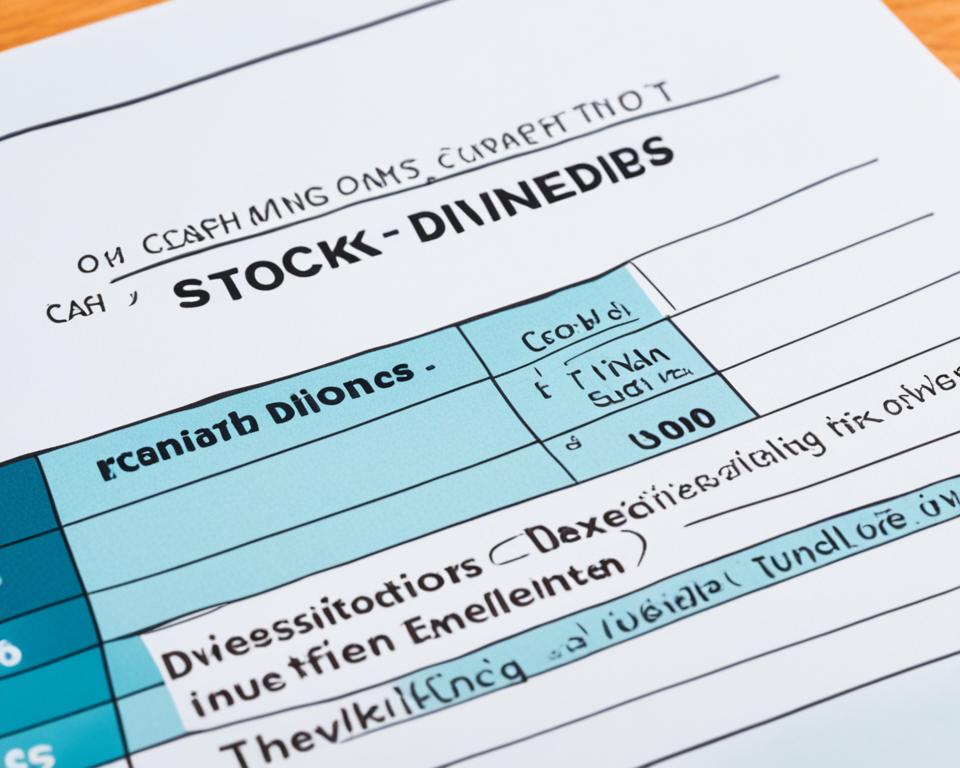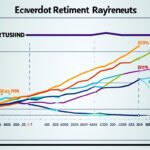As an investor, when you receive dividends, you’re tapping into a stream of income that can bolster your financial portfolio. However, have you considered the tax treatment of dividends and what that means for your investment earnings?
Understanding the tax implications of receiving dividends is critical. Whether those dividends are qualified or nonqualified affects how much you owe the IRS and can influence your investment strategies. Moreover, tools like a dividend tax calculator are essential for forecasting your tax dues and ensuring you aren’t caught off guard when tax season arrives.
Your investment journey involves navigating through the waters of receiving dividends tax without allowing it to erode your gains. The key is to be equipped with knowledge and strategies that can help mitigate these taxes effectively.
Key Takeaways
- Dividends are taxable events that can impact your investment returns.
- Qualified dividends are taxed at a more favorable capital gains rate, while non-qualified dividends are taxed as ordinary income.
- Investing through tax-advantaged accounts like Roth IRAs can shelter your dividends from immediate taxation.
- Understanding the holding period for dividends can help in achieving the qualified tax status.
- Reinvested dividends, although not received in cash, are subject to tax, necessitating careful planning.
Understanding Dividend Income and Taxation
Dividends often represent an enticing stream of revenue for investors, offering a return on equity that can substantially augment one’s financial portfolio. Yet, navigating the murky waters of dividend tax implications necessitates a nuanced understanding. As you delve into investment opportunities that produce dividends, it’s paramount to comprehend how these financial benefits can affect your overall tax situation.
Defining Dividends in the Context of Investments
Within the investment landscape, dividends play a pivotal role. Companies distribute a portion of their earnings to shareholders in the form of money, additional stock, or other assets. These payouts largely originate from U.S. corporations, including mutual funds and other entities structured as partnerships, trusts, or S corporations. Dividends have become a cornerstone for income-focused investors and understanding their tax treatment is essential for efficient financial planning.
Categories of Dividends: Qualified vs. Non-qualified
While dividends can augment your income, they also beckon tax considerations. Distinctions stem from the type of dividend received: ordinary or qualified. Ordinary dividends are frequently encountered by investors and are taxed as regular income. Contrastingly, qualified dividends boast more favorable treatment, paralleling long-term capital gains taxes, thus potentially reducing dividends tax implications significantly.
To benefit from the reduced tax rates associated with qualified dividends, specific criteria must be met. Primarily, the dividend must be issued by either a U.S. company or a qualified foreign corporation, and there’s a holding period requirement where the shares must be owned for a designated timeframe surrounding the ex-dividend date. It’s this dichotomy between ordinary and qualified dividends that inject stock dividends tax considerations directly into your investment strategies.
| Dividend Type | Typical Source | Classification | Tax Treatment |
|---|---|---|---|
| Ordinary | U.S./Foreign Corporations,S Corporations, Trusts | Non-qualified | Taxed as regular income |
| Qualified | U.S. Corporations, Select Foreign Corporations | Qualified | Taxed at capital gains rate |
Whether embarking on new investment ventures or evaluating your current portfolio, stay informed about the basis of dividends and the inherent dividends tax implications. In doing so, you position yourself to maximize returns while adeptly managing the tax responsibilities that accompany dividend income.
Qualified Dividends and Reduced Tax Rates
As you explore your dividend investment options, it’s crucial to differentiate between ordinary dividends and those known as ‘qualified dividends,’ which benefit from reduced dividend tax rates. Qualified dividends are especially noteworthy for their favorable tax treatment and can be a smart way to enhance the efficiency of your investment portfolio.
Eligibility Criteria for Qualified Dividends
To qualify for the lower tax rates afforded to qualified dividends, which align with capital gains tax dividends, there are specific requirements that must be met. Not only does the issuing entity need to be a U.S. corporation, or a qualifying foreign corporation, but there’s also a minimum holding period involved. As an investor, you need to hold the dividend-paying stock for more than 60 days during the 121-day period beginning two months before the ex-dividend date. This strategic period is pivotal since it determines the tax status of these dividends.
Impacts on Your Effective Tax Rate
Embracing qualified dividends can be likened to finding a tax haven within the tumultuous ocean of investment. Depending on which income bracket you fall into, these dividends can enjoy a 0%, 15%, or a 20% tax rate—substantially lower than the higher rates you may encounter with ordinary income. By keeping a careful watch on your holdings and meeting the qualified dividend criteria, you can potentially steer your investments into more profitable waters after taxes.
Note: The information provided here is for educational purposes and does not substitute for professional tax advice. Make sure to consult with a tax professional to consider your individual circumstances and for the most current tax guidelines.
Nonqualified or Ordinary Dividends and Their Tax Treatment
When it comes to your investment income, understanding the tax implications is crucial. Not all dividends are created equal, especially in the eyes of the Internal Revenue Service. Nonqualified, or ordinary dividends, do not enjoy the lower tax rates of their qualified counterparts and are taxed at standard income tax rates. This means they are taxed just like your wages—so, as your income increases, so too might your tax liability from nonqualified dividends. To navigate the tricky waters of receiving dividends tax, savvy investors often turn to a reliable dividend tax calculator for clear foresight on their tax dues.

How Nonqualified Dividends are Taxed
You might find that many of the dividends you receive from your investments are classified as nonqualified. These are the dividends paid out from earnings that do not meet the criteria set forth by the IRS for more favorable tax treatment. As a result, these dividends are taxed according to your income tax bracket. It’s crucial to accurately report these dividends on your annual tax return, and using a dividend tax calculator can help ensure you’re not caught off-guard by unexpected tax obligations.
Comparing Ordinary Income Tax Rates
Investing in dividend-paying stocks seems straightforward, but when it’s time to pay taxes, the complexity unfolds. Your ordinary dividends are lumped with your other income—such as salaries, bonuses, and interest earnings—which can push you into a higher tax bracket, significantly affecting your cash flow. If you’re using a dividend tax calculator, it can guide you through this intricate process by estimating your potential tax on investments, including non-qualified dividends, based on your total income and filing status.
The following table illustrates the tax rates for different income brackets, emphasizing how ordinary dividends are taxed at the same rates as regular income:
| Income Bracket | Ordinary Income Tax Rate | Tax Rate for Ordinary Dividends |
|---|---|---|
| $0 – $9,875 | 10% | 10% |
| $9,876 – $40,125 | 12% | 12% |
| $40,126 – $85,525 | 22% | 22% |
| $85,526 – $163,300 | 24% | 24% |
| $163,301 – $207,350 | 32% | 32% |
| $207,351 – $518,400 | 35% | 35% |
| $518,401 and more | 37% | 37% |
In conclusion, your nonqualified dividends can have a significant impact on your taxes, potentially bumping you into a higher tax bracket. By understanding the receiving dividends tax implications and using tools like a dividend tax calculator, you can more effectively plan your investment strategy and budget for the tax season.
Overview of Dividend Tax Rates
Dividends provide a vital income stream to many investors, but it’s essential to understand how these earnings are taxed to correctly forecast the impact on one’s financial health. The tax treatment of dividends can vary significantly, and knowing the difference between capital gains tax dividends and ordinary income can be advantageous for strategic investment planning.
How Tax Brackets Influence Dividend Taxes
Your tax bracket is the central factor that determines the rate at which your dividends will be taxed. As you move up in income, the percentage of tax on nonqualified dividends increases because it parallels your marginal tax rate. Qualified dividends, favored with lower tax rates, are subject to your capital gains tax rate which may differ from your ordinary income tax rate.
Dividend Tax Rate Breakdown for Different Filing Statuses
Recognizing the impact your filing status has on dividend taxes can help in effective tax planning. The Internal Revenue Service (IRS) lays out clear tax brackets that directly correlate to how much you’re expected to pay on both qualified and nonqualified dividends. Below, a breakdown illustrates how these rates may apply to your particular filing status:
| Filing Status | Income Range | Qualified Dividend Tax Rate | Ordinary Dividend Tax Rate |
|---|---|---|---|
| Single | $0 – $40,400 | 0% | 10% – 37% |
| Single | $40,401 – $445,850 | 15% | 10% – 37% |
| Single | $445,851 or more | 20% | 10% – 37% |
| Married Filing Jointly | $0 – $80,800 | 0% | 10% – 37% |
| Married Filing Jointly | $80,801 – $501,600 | 15% | 10% – 37% |
| Married Filing Jointly | $501,601 or more | 20% | 10% – 37% |
| Head of Household | $0 – $54,100 | 0% | 10% – 37% |
| Head of Household | $54,101 – $473,750 | 15% | 10% – 37% |
| Head of Household | $473,751 or more | 20% | 10% – 37% |
Remember, maintaining an accurate understanding of where you fall within these income thresholds is key. This will not only help you anticipate the tax treatment of dividends come tax time but also enable you to adopt tax-smart investment strategies throughout the year.
Strategies to Minimize Dividend Tax
As an investor, you’re likely always looking for ways to minimize the tax burden on your investments. When it comes to dividends, understanding and applying some key strategies can significantly lower your tax liability. By leveraging tax-advantaged accounts and mindful timing of your dividend investments, you can enjoy more of your returns now and in the future.
Addressing the dividend tax implications with strategic planning means staying ahead of the game. Let’s explore a couple of effective techniques that could make a notable difference in your post-tax income from dividends.
Utilizing Tax-Advantaged Accounts for Dividends
One of the most straightforward ways to shield your dividends from taxes is to use tax-advantaged accounts such as Individual Retirement Accounts (IRAs) or 401(k)s. These accounts offer tax benefits that can be particularly potent for dividends.
- Traditional IRA: Dividends in these accounts grow tax-deferred, helping your investments compound more quickly over time.
- Roth IRA: This account type offers tax-free growth and withdrawals, meaning dividends accumulated in a Roth IRA are yours to keep without a tax deduction.
By wisely placing dividend-paying stocks inside these tax-advantaged vehicles, you can sidestep immediate tax dues and enhance the long-term value of your portfolio.
Timing and Holding Period Considerations
The timing of your dividend investments also plays a pivotal role in their tax treatment. Particularly, the holding period of the stock influences whether dividends received are considered qualified or nonqualified, which, in turn, affects the tax rate.
A critical tip is to hold your dividend-paying stock for at least 61 days during the 121-day period starting 60 days before the ex-dividend date. Meeting this criterion can ensure the dividends are qualified, subjecting them to a lower tax rate.
Using a dividend tax calculator can be invaluable here. It allows you to simulate various scenarios to determine the optimal length of investment time before churning your holdings, helping you to maintain qualified status and minimize tax obligations.
With these strategies, you can navigate dividend tax implications more effectively. Plan your investments to take full advantage of tax laws, and you’ll be able to reinvest the savings and accelerate the growth of your portfolio.
The Role of Tax-Exempt Accounts in Managing Dividend Taxes
Investing in dividend-paying stocks within a tax-exempt account can be a game-changer for managing your stock dividends tax. These types of accounts, such as Roth IRAs, allow your investments to flourish without the immediate burden of taxes nibbling away at your returns. Considering your future financial goals and current tax status can aid in deciding whether a tax-exempt account could serve as a strategic haven for your dividend earnings.

Benefits of a Roth IRA for Dividend Investment
When you deploy a Roth IRA to house your dividend investments, the advantages are multifold. Not only do you get the chance to grow your dividends tax-free, but withdrawals made after certain conditions are met also dodge the tax bullet. This is particularly beneficial if you anticipate being in a higher tax bracket in the future, as the dividend tax rates you would avoid could be substantial. Consider Roth IRA as your ally, providing a tax-free shield for your dividends and helping you maintain more of your hard-earned investment income.
When to Consider a Traditional IRA or 401(k)
On the other side of the tax-advantaged spectrum are Traditional IRAs and 401(k)s, where your dividends can grow tax-deferred. While you may have to pay taxes at your ordinary income rate upon withdrawal, leveraging these accounts can defer the tax pain until a later date—possibly when your tax rate is lower in retirement. These accounts may better suit you if you’re currently in a high tax bracket and predict a lower rate during your golden years, enabling you to navigate stock dividends tax more efficiently.
Tax Reporting Requirements for Dividend Income
As you dip your toes into the investing waters, it’s important to stay afloat with the tax reporting requirements that come with dividend income. Understanding how to accurately declare dividends on your tax return ensures you remain in good standing with the IRS and are able to navigate the dividends tax implications smoothly. Let’s delve into the requisite forms and your reporting obligations to help you steer clear of choppy tax waters.
Understanding Form 1099-DIV and Schedule K-1
If your investments have yielded dividends, you’ll likely encounter Form 1099-DIV. This form is dispatched by companies, funds, or brokers who have paid you $10 or more in dividends. Your received dividends, whether qualified with preferential tax treatment or nonqualified, impacting your bottom line differently, are distinctly reported here. It serves as a compass guiding you through the receiving dividends tax landscape.
Investments through entities such as partnerships or trusts will introduce you to Schedule K-1. This form delineates your proportionate share of dividends from these investments and is essential for an accurate portrayal of your taxable earnings. With this knowledge in tow, completing your tax returns becomes a more navigable task.
Reporting Obligations for Investors
It’s crucial for investors like you to report all taxable dividends. Even if a Form 1099-DIV or Schedule K-1 doesn’t find its way to your mailbox, the IRS expects you to declare these earnings on your tax return. Understating or omitting dividend income can lead to wavy tax penalties, a scenario better to be avoided. Lean on the structured information from your forms, and pair it with a diligent approach to reporting, to mitigate the dividends tax implications and ensure a smoother sail through tax season.
How Reinvested Dividends Influence Taxes
When you opt for Dividend Reinvestment Plans (DRIPs), you’re choosing to reinvest the earnings from your investments back into additional shares. What seems like a simple reinvestment strategy actually carries with it notable tax considerations. Discovering the tax treatment of dividends in this context is essential for a savvy investor.
Dividend Reinvestment Plans (DRIPs) and Taxable Events
While participating in a DRIP allows you to purchase more shares automatically, this convenience doesn’t circumvent the tax responsibilities. The Internal Revenue Service (IRS) treats these reinvested dividends as taxable income, akin to cash dividends. This means that, even though you’re not pocketing any cash, you’re still obligated to report this income on your tax returns. A dividend tax calculator can be particularly helpful in estimating the tax obligations that arise from reinvested dividends.
Implications for Share Basis and Capital Gains
It’s not just about the dividends themselves but also how they influence your position when it’s time to sell. The accumulative nature of DRIPs affects the basis—or the original value—of your investment in the stock. With each reinvestment, your share basis changes, which can have a significant impact when calculating capital gains or losses later on. Properly tracking these transactions is crucial for accurately reporting your taxes and making the most out of your investments. Ensuring precise documentation will aid in avoiding confusion and discrepancies, potentially saving you from a stressful audit situation.
Being proactive with recording each DRIP transaction will simplify the process when using your dividend tax calculator to gauge the taxes due. Understanding these mechanics isn’t just tax-smart—it’s an integral part of your investment strategy.
Stock Dividends vs. Cash Dividends
Dividends are a critical component of an investment portfolio, but the form in which they’re paid can affect your tax strategy. Two popular forms of dividend distribution are stock and cash dividends, and each carries unique dividend tax implications. Understanding the nuances can guide you in choosing the right investments to optimize your post-tax returns.
Different Tax Treatments Explained
When you receive stock dividends, you’re given additional company shares instead of cash. One of the key stock dividends tax advantages is that these are generally not immediately taxable. It’s only when you decide to sell the shares that capital gains tax could apply, potentially affecting your investment income. In contrast, cash dividends are usually taxable in the year you receive them, adding to your annual income tax considerations.
Deciding Between Cash or Stock Options
Your decision between stock and cash dividends may depend on several factors, including your investment goals, need for liquidity, and current tax situation. Are you looking for immediate income, or are you focusing on long-term growth? Electing for stock dividends might appear to be a method to defer taxes, but if not executed strategically, this option can still lead to a dividend tax implication, especially if you’re given the choice and the fair market value of the shares is ascertainable at distribution.

Choosing cash dividends provides immediate liquidity, but remember that this income is often taxed at your ordinary income tax rate. On the other hand, stock dividends may increase the value of your investment without an immediate tax event, providing potential for future growth. Use this information to align your dividend decisions with your financial strategies and manage potential tax liabilities.
Ultimately, an informed approach to dividends will enable you to navigate the complexities of dividend tax implications. As you build your investment portfolio, consider how these two dividend types might serve you best, and remember to consult with a tax professional for advice tailored to your unique financial situation.
Capital Gains and Dividend Investments
Investors seeking to maximize their portfolio’s potential need to grasp the relationship between capital gains tax dividends and their investment choices. Dividend-bearing investments not only yield ongoing returns but also have specific tax treatment of dividends that can significantly affect an investor’s capital when shares are sold for profit.
Understanding Capital Gains Tax Dividends
Whenever you sell dividend-paying stocks at a profit, a capital gains tax event is triggered. This tax is levied based on the difference between the purchase price and the selling price of your investments, reflecting the appreciation of your assets over time. The amount of capital gains tax you incur on these dividends can have a pivotal impact on your investment earnings, underlining the importance of understanding the tax treatment of dividends for effective investment planning.
Implementing Tax-Loss Harvesting Strategies
To ameliorate the effect of capital gains tax, investors may opt for tax-loss harvesting. This strategy involves selling securities at a loss to offset capital gains on other investments. However, the IRS has instituted the wash-sale rule, which bars investors from claiming a tax loss if they repurchase the same or a substantially identical stock within 30 days before or after the sale. Thus, tax-loss harvesting, when adeptly timed, can be an efficacious means to mitigate the impact of capital gains tax on your dividends.
By aligning with the right approach to dividend investments, you can shield your returns and augment your financial growth. Implementation of these insights into your regular investment evaluations can lead to substantial tax savings and a healthier portfolio.
Considerations for Mutual Funds and Dividend Taxes
When it’s time to review your mutual fund investments, a crucial aspect to consider is the tax liability associated with dividends. Similar to individual stocks, mutual funds can generate both dividend income and capital gains distributions, each with unique tax implications. Understanding the differences between these types of earnings and how they affect your dividends tax implications is key to managing your portfolio’s tax-efficiency.
Tax Liability for Mutual Fund Shareholders
As a mutual fund shareholder, the dividends received are a portion of the earnings distributed by the fund from its investments. It’s important to remember that these dividends are typically taxable events. The tax rate that applies depends on whether the dividends are classified as qualified or nonqualified. Keeping in mind the receiving dividends tax rules, you should expect to report these dividends on your annual tax return.
Capital Gains Distributions vs. Dividend Income
Mutual funds often realize capital gains from the sale of securities within their portfolio, and these gains are passed on to investors as capital gains distributions. Unlike dividend income, which can be qualified or nonqualified, capital gains distributions are taxed as long-term capital gains, irrespective of how long you’ve held your mutual fund shares. This distinction can result in potential tax savings, as long-term capital gains rates are typically lower than the rates for ordinary income.
Here’s a table that contrasts the tax treatment of dividend income and capital gains distributions for mutual fund shareholders:
| Earnings Type | Tax Treatment |
|---|---|
| Dividend Income | Qualified dividends taxed at lower capital gains rates; Nonqualified dividends taxed as ordinary income |
| Capital Gains Distributions | Taxed as long-term capital gains regardless of holding period |
Receiving year-end statements such as Form 1099-DIV from your mutual fund can help clarify the types of distributions you’ve received, guiding your tax filing process. Always consult a tax professional to navigate these detailed disclosures to ensure proper reporting and to optimize your tax standing.
Conclusion
Understanding what the tax implications of receiving dividends are is integral to any investment strategy. When dividends land in your account, they bring with them a tax scenario that’s as inescapable as the change of seasons. Whether these dividends are qualified and receive the preferential capital gains rate or taxed as ordinary income, the influence on your fiscal health is significant. Recognizing this importance, employing a dividend tax calculator becomes an indispensable resource, allowing you to project tax liabilities and plan accordingly.
Key Takeaways on Dividend Tax Implications
Your take-home message is clear: the taxation of dividends requires your vigilant attention. Knowing the difference between qualified and non-qualified dividends, keeping dividends in tax-advantaged accounts, and understanding the import of holding periods for tax rates is crucial. Whether you’re neck-deep in stacks of 1099-DIVs or setting up your first DRIP, the compass for navigating these taxing waters lies in being well-informed and prepared.
Final Thoughts on Smart Dividend Tax Planning
As you cradle your financial future in your hands, remember that smart dividend tax planning isn’t just about increasing your wealth—it’s about preserving it. It involves more than just numbers; it requires a strategy that looks at the big picture of your income, filing status, and future financial goals. Don’t hesitate to consult a tax professional to ensure that when tax season rolls around, your dividends are working for you—and not the other way around. By being proactive and utilizing available tools, such as a dividend tax calculator, you’re taking a firm step towards a thriving investment journey, maximizing your gains with an eye on the horizon.
FAQ
What are the different categories of dividends for tax purposes?
Dividends are categorized as either qualified or non-qualified for tax purposes. Qualified dividends benefit from lower tax rates similar to long-term capital gains, while non-qualified dividends are taxed at an individual’s ordinary income tax rate.
What are the eligibility criteria for dividends to be considered qualified?
For dividends to be considered qualified, they must be paid by a U.S. company or a qualifying foreign corporation and the shares must be held for more than 60 days during a 121-day period beginning 60 days before the ex-dividend date.
How are nonqualified dividends taxed?
Nonqualified or ordinary dividends are taxed according to your standard income tax rates. These rates are the same as those that apply to your regular wage or salary income.
How do tax brackets affect dividend taxes?
Tax brackets determine the rate at which your qualified dividends are taxed. Depending on your income level and filing status, qualified dividends can be taxed at 0%, 15%, or 20%, mirroring the rates for long-term capital gains.
What are the tax benefits of using tax-advantaged accounts for dividend investments?
Tax-advantaged accounts like IRAs and 401(k)s allow your dividend investments to potentially grow tax-deferred or tax-free, depending on the type of account. This can significantly reduce the immediate tax burden on dividend income.
What should you consider when deciding between a Roth IRA and a Traditional IRA for dividend investing?
You should consider your current and expected future tax brackets when choosing between a Roth IRA and a Traditional IRA. Roth IRAs offer tax-free growth and withdrawals for qualified distributions, while Traditional IRAs provide tax-deferred growth with taxes on withdrawals at future ordinary income rates.
What is Form 1099-DIV and what is its relevance to dividend income reporting?
Form 1099-DIV is a document issued by banks or other financial institutions to report the dividends and other distributions to investors. It differentiates between qualified and nonqualified dividends, which is crucial for accurately reporting taxable income on your tax return.
How do reinvested dividends impact your taxes?
Reinvested dividends are still considered taxable income, similar to dividends paid out in cash. They also affect the cost basis of the investment, which must be accounted for when calculating capital gains or losses.
What are the tax implications of receiving stock dividends?
Generally, stock dividends are not taxed until the shares are sold. However, certain choices, like opting for stock dividends instead of cash, can create a tax event under specific circumstances.
How does capital gains tax apply to dividend investments?
When you sell shares of a dividend-paying stock at a profit, you may be subject to capital gains tax. Tax-loss harvesting can help offset these gains by selling other investments at a loss.
Are mutual fund shareholders subject to taxes on dividends like individual stock investors?
Yes, mutual fund shareholders can face tax liabilities on dividends similar to individual stock investors. Dividends and capital gains distributions from mutual funds are taxed differently and must be reported on Form 1099-DIV.












